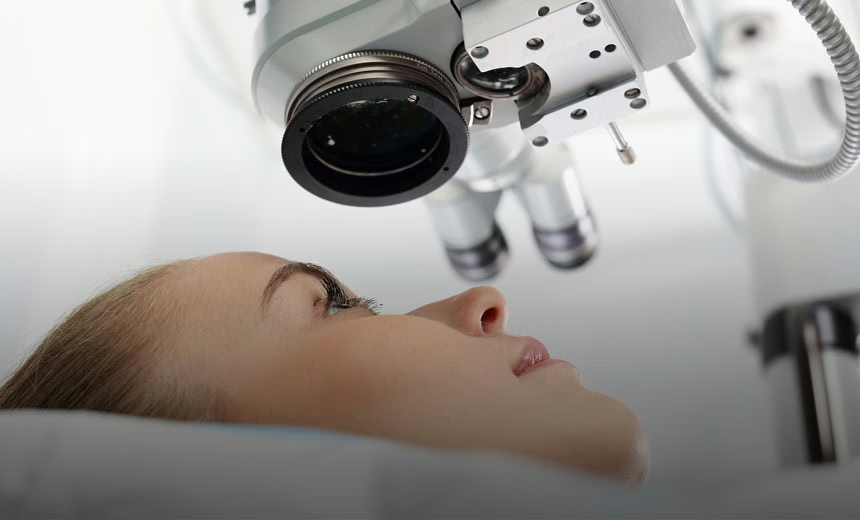"*" indicates required fields
Focus on laser eye surgery: Part 4

What to expect on the day of the surgery
We continue our series of articles answering frequently asked questions about laser eye surgery.
In this post, we’ll look at what actually takes place during laser eye surgery, so you know what to expect on the day.
Before surgery
Before coming to the clinic for your surgery, you need to follow these preparation guidelines. You can expect to be in the clinic for around two hours, and in the laser suite for no more than 30 minutes. If you need laser eye surgery on both eyes, this will generally be done on the same day.
Prior to the surgery, anaesthetic eye drops will be applied to numb your eyes. You can also choose to have a mild oral sedative to help relax you before the procedure – this is optional. After allowing a short time for the sedative to work, you will be shown to the laser suite.
During surgery
Before you enter the laser suite, the laser will have been pre-programmed to correct your refractive error. Your surgeon will talk to you throughout the process to make sure you know what is going to happen next.
The laser will be moved into position after you lie flat on the bed, so that the eye being operated on is directly in line with it. To prevent blinking, a prop called a speculum will be fitted over your eye to hold it open. The laser has an infrared eye-tracker that measures and compensates for any movement in your eye.
Your surgeon will raise the bed so that the laser fits comfortably around your eye and will let you know when the procedure is about to start.
LASIK
Lasik is a two-step vision correction procedure. In the first step, the surgeon uses either a femtosecond laser or a microkeratome to create a hinged flap on the top layer of your cornea, exposing the tissue bed underneath. You may feel slight pressure during this stage. In the second step, the excimer laser is used to reshape the cornea. As the laser moves across the cornea, you may feel a slight sensation but no pain. Once reshaping is complete, the surgeon gently replaces the corneal flap and the healing process begins immediately.
SMILE®
This is a one-step, one-laser vision correction procedure. The surgeon uses a femtosecond laser to create a 3 mm keyhole entry point. Next, the laser creates a precise lens-shaped disc of tissue within the cornea. This disc of tissue (called a lenticule) is then removed through the keyhole incision. During the procedure, you may feel some pressure or mild discomfort but no pain.
ASLA
ASLA is a two-step, one-laser procedure. In the first step, the surgeon applies a topical solution to soften and remove the top layer of corneal cells (the same process is achieved by the excimer laser in transPRK). In the second step, an excimer laser is used to reshape the corneal tissue. During the laser step, you may feel a slight sensation but no pain. Afterwards, a ‘bandage’ contact lens is placed on top of the eye to assist with the healing process.
Following the laser procedure for the first eye, the speculum will be removed and the procedure will be repeated on your second eye (if required).
Ultimately, all three techniques achieve the same result – that is, restoring your vision by correcting your specific refractive error.
The procedure that is best for you will have been established during your pre-operative consultation.
After surgery
Once the laser procedure is complete, you will be helped off the bed and led into the recovery room. You may be able to see distant objects, but your vision will be slightly blurry. This is normal. You will need to remain in the recovery room for around half an hour to allow your eyes to adjust and the effects of the sedative to wear off.
Before you leave, you’ll be given medicated eye drops to use and a follow-up appointment will be made for later that same day or the next day. A friend or family member must accompany you when you are discharged – you won’t be allowed to drive home. Once home, you should rest for the remainder of the day.
Next time, we’ll explain what is involved during the post-operative recovery period and how long vision takes to stabilise following each procedure.
Related posts:
SMILE® is a registered trademark of Carl Zeiss Meditec
References
- Choice. A guide to laser eye surgery. NSW, 11 August 2020. Available at https://www.choice.com.au/health-and-body/optical-and-hearing/optical/articles/guide-to-laser-eye-surgery [Accessed 6 January 2021].
- Healthdirect. Laser eye surgery. NSW, 2019. Available at https://www.healthdirect.gov.au/laser-eye-surgery [Accessed 6 January 2021].
- Wilkinson JM, Cozine EW, Kahn AR. Refractive Eye Surgery: Helping Patients Make Informed Decisions About LASIK. Am Fam Physician 2017;95(10):637–44.
- Somani SN, Moshirfar M, Patel BC. Photorefractive Keratectomy. In: StatPearls [Internet]. Treasure Island, FL: StatPearls Publishing; 2020.
- Doane JF, Cauble JE, Rickstrew JJ, Tuckfield JQ. Small Incision Lenticule Extraction SMILE – The Future of Refractive Surgery is Here. Mo Med 2018;115(1):82–4.
The information on this page is general in nature. All medical and surgical procedures have potential benefits and risks. Consult your ophthalmologist for specific medical advice.
Date last reviewed: 2025-05-20 | Date for next review: 2027-05-20
